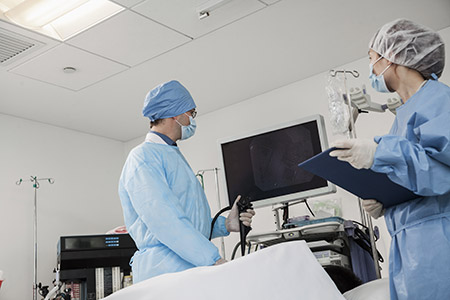 Your Doctor may need to get a better look at your lungs to determine lung damage or disease. To do this a Fiber optic Bronchoscopy (pronounced bron-kos’ko-pi) will be scheduled. The bronchoscopy is done by inserting a thin tube-like instrument, with a small mini-camera attached to the tip, through the nose or mouth into the airways of the lungs. This allows the Doctor to have a visual view of the lungs and take samples of the mucus or tissue, if needed.
Your Doctor may need to get a better look at your lungs to determine lung damage or disease. To do this a Fiber optic Bronchoscopy (pronounced bron-kos’ko-pi) will be scheduled. The bronchoscopy is done by inserting a thin tube-like instrument, with a small mini-camera attached to the tip, through the nose or mouth into the airways of the lungs. This allows the Doctor to have a visual view of the lungs and take samples of the mucus or tissue, if needed.
Reasons for a Bronchoscopy
Your Doctor may schedule a Bronchoscopy for any of the following:
- A serious infection in your upper respiratory region.
- A spot or abnormal finding on your lung in an X-ray or CT scan
- A collapsed lung that is on-going
- Coughing up blood
- Breathing that is noisy or narrowing of the airway
How do I get ready for a Bronchoscopy?
A Bronchoscopy will require that no food is taken after midnight. If there is a critical condition where a feeding tube is inserted, feedings will be stopped several hours before the test to insure the stomach is empty.
A small amount of a sedative will be given to make you sleepy and relaxed. This may also help to make your forget any unpleasant sensation you may experience during the test.
Before beginning the procedure, a medicine is sprayed into your throat to numb the area to prevent coughing or gagging as the scope is inserted.
What is it going to be like?
Your Doctor will explain the procedure in detail. Most likely you will be lying down with the head of the bed tilted slightly. The Bronchoscope is inserted slowly down the back of the throat, through the vocal chords and into the airways. The numbing spray given before the procedure will make sure this is not painful.
Are there any risks?
There are risks involved in any procedure, but less than 5% of those having a Bronchoscopy have any problems. The risks could be:
- Discomfort and coughing
- Oxygen levels may fall during the procedure, but returns to normal quickly, once the procedure is completed
- Injury to the lung by the procedure which causes a leakage of air and may cause the lung to collapse. This is extremely rare.
- Bleeding can occur, but happens more frequently if there is inflammation around the airway from infection or disease. Medication can be given to stop the bleeding.
So what happens after?
This depends on the nature of the infection or disease that required the scope to be performed. Wake-up times depend on the person. In critically ill patients, it can take much longer to get fully awake. Other issues, such as a ventilator will also determine recovery time.
Once you are awake the Doctor will be able to discuss what the Doctor saw right away, but lab results of any samples will take longer and require a follow-up visit.
When you leave, you might experience a mild sore throat, hoarseness, muscle aches or cough. If you experience pain in your chest or shortness of breath contact your Doctor immediately.
Talk to us